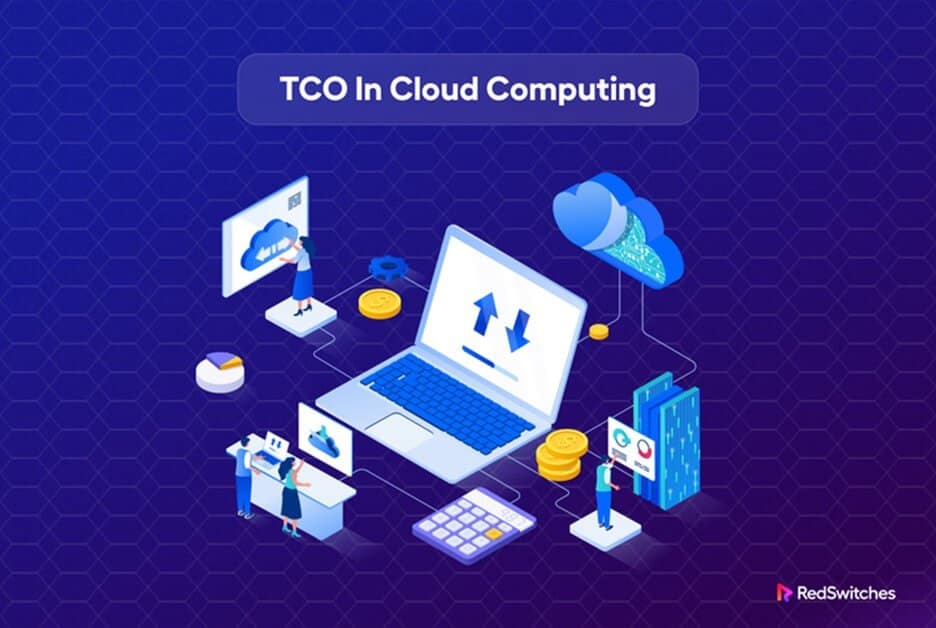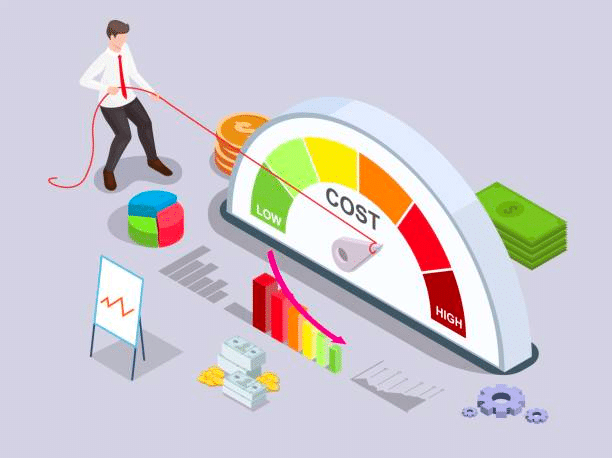Investing in the right tools and infrastructure can make or break a business in today’s digital age. Understanding the total cost of ownership (TCO) is crucial for making informed decisions and ensuring profitability. TCO is the cumulative sum of all costs involved in an asset’s purchase, operation, and maintenance over its lifetime. It enables businesses to understand the cost of a tool beyond its initial purchase price and helps calculate ROI. As your company invests in cloud computing solutions, you may ask yourself, ‘What is TCO in cloud computing?’
Cloud computing has revolutionized how businesses operate, and estimating the TCO of cloud infrastructure is vital for organizations considering migration. Vendors typically present their pricing plans at the base level.
However, evaluating all resources required for deployment and operation is crucial to estimate the total cost of cloud infrastructure. Studies have shown that 76% of organizations measure their cloud progress according to cost efficiency.
This article will help you answer questions such as ‘What does TCO stand for in cloud computing?’ and ‘How can I reduce my total cost of ownership in cloud computing?’ We will delve into the importance of estimating cloud costs ahead of migration, reducing TCO, cloud cost optimization trends, and cloud financial management. By the end of this article, readers will have a clear understanding of TCO in cloud computing and its significance in making informed business decisions.
Table of Content
- What is Cloud TCO?
- What Is Lower TCO?
- How To Calculate TCO For Software Acquisitions?
- What Are The Steps For Calculating Cloud TCO?
- Why Is TCO Important?
- How To Reduce TCO?
- What Are Some Cloud Cost Optimization Trends?
- How To Cost Control and Manage Cloud Financial?
- How To Manage Orphaned Resources?
- How To Manage Over-Provisioned Resources?
- Switch To RedSwitches Today
- Key Takeaways
What is Cloud TCO?
The total cost of ownership in cloud computing is a critical metric for evaluating the costs of adopting and operating cloud infrastructure. It refers to the overall expenses of setting up, maintaining, and provisioning cloud systems. When migrating to the cloud, performing a TCO analysis helps organizations to compare different deployment options and understand associated costs. This enables them to plan and budget effectively for their cloud adoption.
One of the main challenges in calculating cloud TCO is the dynamic nature of cloud environments. It is not sufficient to compare the running costs of the cloud with an organization’s on-premises system. The initial purchase of hardware and software typically dominates the prices of on-premises infrastructure. At the same time, cloud computing costs are based on monthly subscriptions or pay-per-use models.
Organizations must also consider each option’s indirect and intangible costs to calculate cloud TCO accurately. These can include the benefits of a cloud solution, such as faster time to market, increased productivity, and elasticity of demand. By capturing these key cost considerations, organizations can gain a workable model that they can use to make informed decisions and understand the return on investment of cloud adoption.
What Is Lower TCO?
‘Lower TCO,’ or lower cloud computing total cost of ownership, refers to the reduced cost of implementing and operating a cloud infrastructure compared to traditional on-premises solutions. Cloud computing often leads to lower TCO due to eliminating up-front hardware and software costs and the ability to pay only for the resources used on a pay-as-you-go basis.
Cloud solutions provide increased flexibility and scalability, allowing businesses to quickly and easily adjust resources to meet changing demands. However, factors such as inefficient resource allocation, inadequate monitoring, and poor security practices can negatively impact TCO.
Businesses can achieve a lower TCO by optimizing resource usage. They can also do so by implementing efficient monitoring and cost management strategies and adopting best security practices in the cloud. This helps reduce cloud costs and maximize returns on investment.
How To Calculate TCO For Software Acquisitions?
To acquire cloud-based software, understanding the total cost of ownership in cloud computing is crucial. A comprehensive TCO calculation includes licensing, maintenance, data transfer, and training costs.
Assessing critical factors like the nature of the organization, cloud solution functions, performance requirements, and risk management is essential for calculating TCO. You must also evaluate cloud operation costs, legal compliance costs, and migrating existing applications. Before relocating to the cloud, you should also consider the TCO of existing on-premises systems.
To compare TCO, businesses can compare predicted monthly cloud costs with expenses related to on-premises operations. Some such expenses include license fees, storage resources, upgrades, utility costs, and resource inefficiencies. This method provides a reliable estimate of the cost-effectiveness of cloud deployment.
What Are The Steps For Calculating Cloud TCO?
1) Calculate Current IT Infrastructure Costs
The first step in calculating the total cost of ownership for cloud adoption is to evaluate the current IT infrastructure costs. This involves identifying the current system’s direct and indirect costs and estimating the existing workloads.
Consider cost areas such as hardware and infrastructure, data center expenses, software licensing, personnel, disaster recovery, maintenance, upgrade, and security. You should also consider hidden costs associated with system downtime. By thoroughly assessing these cost factors, organizations can better understand their current IT expenses and make informed decisions when considering cloud adoption.
2) Estimate The Cost Of Cloud Acquisitions
The second step in calculating the total cost of ownership in cloud computing involves estimating the cost of operating applications in the cloud. While many on-premises infrastructure costs will not apply to the cloud, it is essential to remember that cloud solutions are not inherently cheaper than on-premises solutions.
Businesses must estimate the cost of migration and monthly cloud services, considering the workload and the specific cloud services being used. The pricing calculators provided by powerful cloud platforms can help estimate monthly cloud costs. Additionally, consultation and training costs should be considered if the team needs more expertise in the migration process.
3) Determine the Intangible Benefits Of the Cloud
The third step in cloud migration is determining the intangible benefits of moving to the cloud. Opportunity costs are associated with not switching to the cloud, including lost opportunities for innovation and challenges in handling demand.
The cloud allows developers to move quickly and respond quickly to market changes and provides elasticity in managing peak loads without downtime. While there may be a larger monthly cloud bill during peak periods, there is no need to maintain redundant infrastructure when the surge is over.
Why Is TCO Important?
Overall, understanding TCO is essential for businesses to make informed decisions about cloud computing and ensure they maximize the benefits of the cloud while minimizing costs and risks.
| Benefits | Impact |
| Cost Savings | By understanding the TCO of cloud computing, businesses can identify cost savings opportunities and optimize their cloud spend. This can lead to significant cost reductions and better allocation of resources. |
| Improved Decision-Making | Understanding TCO in the cloud can help businesses make better decisions when selecting cloud services and providers. This can help them avoid unexpected costs and choose services that align with their business goals. |
| Better Resource Allocation | By understanding TCO, businesses can better allocate resources and plan for future growth. They can make informed decisions about which workloads to move to the cloud and how to optimize their infrastructure to meet changing demands. |
How To Reduce TCO?
Businesses should optimize their infrastructure by scaling up or down as needed, streamlining processes, and improving resource utilization to reduce TCO.
One effective strategy for lowering TCO is to use automation to provision and monitor resources. Automating infrastructure management and monitoring can significantly reduce costs and improve efficiency. Another effective method is to increase reliance on standardization. Designing applications with clear parameters for flexibility and autoscaling can reduce costs by making it easier to manage resources and respond to changes in demand. Eliminating idle or abandoned resources and services is also an effective way to reduce TCO. Businesses can avoid unnecessary costs by regularly reviewing and removing unused resources and services.
Finally, moving away from on-demand pricing to consumption-based pricing and planned or reserved instances can help businesses reduce cloud costs over the long term. By taking these steps, companies can manage their cloud infrastructure more efficiently, reduce costs, and achieve their goals more effectively.
What Are Some Cloud Cost Optimization Trends?
Cloud cost optimization has become increasingly important as more organizations migrate to the cloud. Cloud providers have responded to this need by developing native optimization options that allow businesses to choose the most cost-effective infrastructure. This is particularly crucial when migrating legacy applications to the cloud in an infrastructure as a service (IaaS) deployment, which can be complex and require managing many resources.
In addition to native optimization options, third-party cost optimization tools are becoming more popular, particularly for multi-cloud environments where independence from cloud providers is essential. These tools offer enhanced analytics capabilities to help businesses save money without sacrificing performance.
One emerging trend in cloud cost optimization is adopting cloud financial management (FinOps), which promotes collaboration between DevOps and financial teams. This approach allows for the dynamic application of pricing plans to ensure optimal cost structures for each workload. Improving the management of orphaned resources can also reduce waste and improve utilization. Finally, advanced auto-scaling strategies can help businesses avoid over-provisioning resources, which can be costly.
Cloud cost optimization will evolve and become more sophisticated, with new technologies and strategies emerging to help businesses reduce costs and improve efficiency.
How To Cost Control and Manage Cloud Financial?
In the age of cloud computing, effective cost control is essential for any business. Organizations must take a strategic approach to cloud financial management to optimize their cloud spending and avoid unexpected costs.
Businesses need to have a clear understanding of their cloud services and the associated costs to ensure cost-effectiveness. They can use various cost optimization strategies such as choosing suitable instance types, leveraging discounts and reservations, and avoiding waste by terminating underutilized resources.
Implementing governance policies to monitor and control cloud resource use can optimize cost. Cloud financial management, or FinOps, is a new discipline that promotes collaboration between DevOps and financial teams. It helps organizations gain visibility into their cloud costs and identify more cost-effective alternatives to improve resource utilization.
Tools like cloud cost management software, automated resource optimization tools, and cloud management platforms help manage cloud costs effectively. They optimize resources, monitor usage, and reduce expenses. By leveraging these tools, businesses can effectively monitor and manage their cloud spend and optimize their resources to drive greater efficiency and cost savings.
How To Manage Orphaned Resources?
Regarding cloud computing, “orphaned resources” refer to instances of storage or compute resources launched but then forgotten. They can continue to consume financial resources even when not in use, leading to unnecessary overhead costs.
To manage orphaned resources, it is essential to regularly monitor your cloud environment and identify any instances that are not actively in use. Once identified, you can decommission or terminate these resources to stop them from consuming financial resources.
Best practices for preventing orphaned resources include:
- Establishing clear ownership and accountability for all resources.
- Auditing your cloud environment regularly
- Implementing automation and alerts to ensure resources are only launched when necessary.
By proactively managing your cloud environment, you can avoid the negative impacts of orphaned resources and keep your cloud deployment running smoothly.
How To Manage Over-Provisioned Resources?
Over-provisioned resources are computing resources that provide more capacity than needed for optimal performance, resulting in wasted resources and increased costs. To manage over-provisioned resources, organizations can track resource utilization, reallocate resources, and continuously adjust resource allocation to ensure they remain cost-efficient.
Best practices for optimizing resource allocation in cloud computing include:
- Using advanced auto-scaling capabilities.
- Adopting containerized architectures and orchestrators.
- Embracing serverless computing models.
Implementing these strategies can help organizations reduce costs and improve the efficiency of their cloud infrastructure.
Switch To RedSwitches Today
Are you seeking a reliable cloud hosting provider for your business applications or websites? Look no further than RedSwitches. We offer cloud hosting services with multiple global locations, the latest Intel & AMD CPUs, and 100% network uptime guaranteed. Our product features an instant setup, a complete reboot and reinstall panel, and a range of payment options, including PayPal, Bitcoin, and credit cards.
Our managed services and 24/7 support make us the go-to choice for businesses looking for hassle-free hosting. We offer support via multiple channels, with a response time of just 15 minutes. We don’t require ID documents for payment, unlike our competitors. Join countless satisfied customers who have switched to our superior cloud hosting services.
Key Takeaways
Considering all the expenses associated with a cloud environment, the total cost of ownership in cloud computing is crucial. In this article, we discussed the definition and importance of TCO in cloud computing, the factors affecting TCO, and strategies for reducing TCO, including identifying and managing orphaned and over-provisioned resources, optimizing resource allocation, and selecting the suitable pricing model.
Managing TCO is essential for ensuring cloud operations’ long-term sustainability and success. Organizations can effectively reduce their cloud expenses and improve their bottom line by adopting the right strategies and tools. However, managing TCO requires ongoing monitoring and optimization, as cloud environments are dynamic and constantly evolving.
Now that you know what is tco in cloud computing, you can reap maximum benefits while minimizing expenses by monitoring resource usage, identifying inefficiencies, and adopting best resource allocation and optimization practices for your organization. So, take action today to better manage TCO in your cloud environment and achieve tremendous success in your business operations.



